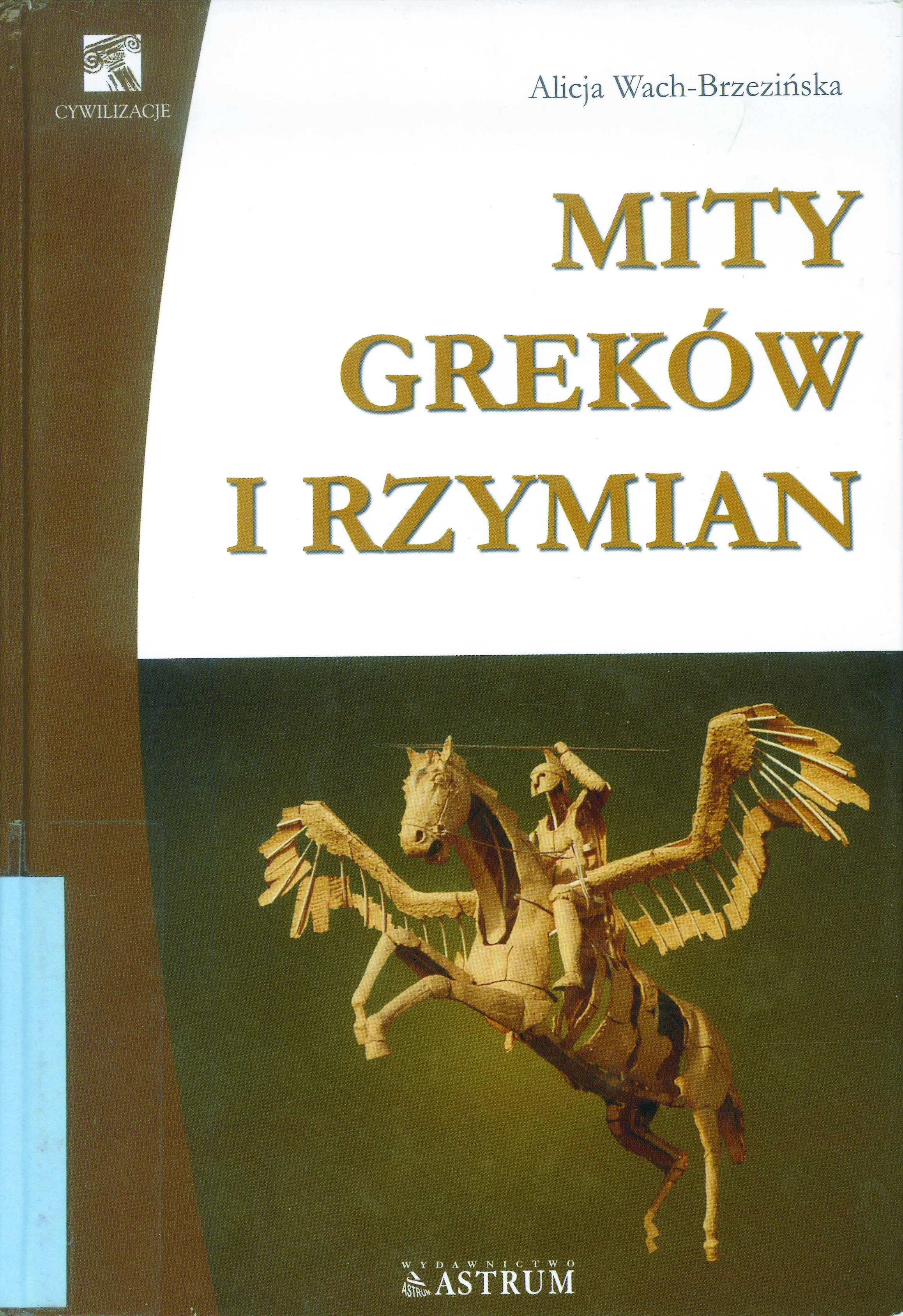Title of the work
Country of the First Edition
Country/countries of popularity
Original Language
First Edition Date
First Edition Details
Alicja Wach-Brzezińska, Mity Greków i Rzymian, “Cywilizacje”. Wrocław: Wydawnictwo Astrum, 2006, 232 pp.
ISBN
Genre
Anthology of myths*
Myths
Target Audience
Children (teenagers)
Cover

Courtesy of Wydawnictwo Astrum, the publisher
Author of the Entry:
Summary: Sebastian Mirecki, University of Warsaw, smirecki@student.uw.edu.pl
Analysis: Marta Pszczolińska, University of Warsaw, m.pszczolinska@al.uw.edu.pl
Peer-reviewer of the Entry:
Katarzyna Marciniak, University of Warsaw, kamar@al.uw.edu.pl
Elżbieta Olechowska, University of Warsaw, elzbieta.olechowska@gmail.com

Photograph courtesy of the Author.
Alicja Wach-Brzezińska
, b. 1974
(Author)
Alicja Wach-Brzezińska is a journalist and writer. After completing high school, she lived, studied, worked, and travelled in France and became fascinated by French literature, cinema, music, and cuisine. Obtained an MA in Romance Philology at the University of Wrocław. In her MA dissertation, she wrote about the natural right to happiness in Voltaire’s philosophy. During her studies, she worked as a translator. She also specialized in European public policy at the Robert Schuman University (Strasbourg III) in Strasbourg. Since 2003, she has been contributing to Gazeta Regionalna, a regional weekly, published in Żarski, Żagański, and Nowosolski districts, as well as in Zielona Góra (Lower Silesia); since 2008, she has worked as an editorial secretary. Mity Greków i Rzymian [Myths of the Greeks and Romans], published in 2006, was her literary debut, followed by another book, Mity starożytnych Egipcjan [Myths of the Ancient Egyptians].
Bio based on the material kindly provided by the Author.
Bio prepared by Sebastian Mirecki, University of Warsaw, smirecki@student.uw.edu.pl
Summary
Based on: Katarzyna Marciniak, Elżbieta Olechowska, Joanna Kłos, Michał Kucharski (eds.), Polish Literature for Children & Young Adults Inspired by Classical Antiquity: A Catalogue, Faculty of “Artes Liberales”, Warsaw: University of Warsaw, 2013, 444 pp.
An anthology of ancient classical myths retold for older adolescents and related to the motif of love in all its manifestations: romantic, conjugal, brotherly, and as well as a passion for art, warfare, hunting, great wealth and so forth. The myths focus on love and other strong emotions, good and bad. This concept has broad connotations – love is both a creative and destructive power; it is a driving force for humans and gods.
Analysis
The book presents 15 chapters on Greek mythology and three on Roman mythology; both parts are preceded by an introduction to the ancient systems of beliefs and genealogies of gods. As the book is aimed at older school children, the author does not avoid describing the violence often present in various Greek and Roman myths and legends. At the same time, while focusing on the motif of love, Wach-Brzezińska tries to gloss over sexual issues, equally ubiquitous in ancient mythology. She mentions relationships but uses evasive descriptions, omissions, or imprecise vocabulary that are not explicit. For example, instead of telling the reader that Demeter had a son, Plutus, and a daughter, Kore, she adds value judgment: “[…] in her early youth it happened that she was imprudent, and the fruit of her youthful passion was Plutus, the son she bore to the Titan Iasion” (p. 39). On the other hand, complicated extramarital relationships are sometimes described freely, like in the chapter The Father of Gods and Queen Hera (Unfaithful Husband and Jealous Wife), where the author presents the many extramarital affairs of Zeus, describing how he seduced women, pursuing new romances and disregarding his wife’s feelings. Similarly, the chapter, Beautiful Aphrodite, Disabled Hephaestus and Proud Ares (Three of Them) presents the relationships of Aphrodite with Hephaestus and with Ares. This is not a praise of marriage because if the union has been imposed by Zeus and was not a love match, Aphrodite’s love affair seems understandable.
The motif of love is expressly identified as the driving force of every myth presented in the book. However, the book does not show the so-called eternal love stories, such as Eros and Psyche, Pyramus and Thisbe or Pygmalion and Galatea. In some cases, the lovers are protagonists (Orpheus and Eurydice, Hector and Andromache). Still, most chapters relate Greek myths and their subplots or spin-offs, even if the content of the stories is far from romantic. E.g., the myth of Sisyphus is entitled: Sisyphus and His Punishment (The Gods’ Favourite Pays for His Love of the Land) but the leading theme of love is difficult to identify throughout the chapter. It is only at the end of his story that the author explains that Sisyphus deliberately exposed Zeus to provide water for his city and its citizens. It is a curious explanation for his behavior because he is presented as an ordinary thief, seducer, and clever swindler which acts against his image as a Corinthian patriot. Similarly, the chapter about Daedalus details many episodes connected to his life and work, including the murder of his nephew, Talos, which resulted in Daedalus’ exile from Athens, his work on Crete, his advice to Theseus to use a ball of thread, his imprisonment by Minos, the famous flight, and finally his stay at King Cocalus’ court on Sicily, but it is hard to notice any love or passion in the story. Daedalus’ actions were neither motivated by love for humankind (as was the case with Prometheus), nor by love for his child (as was the case with Demeter), nor finally, by an obsessive love of wealth or overwhelming greed (as was the case with Midas). The story is entitled Master Daedalus and Icarus, the Dreamer (Flight to Freedom), but even the love of freedom is not the explicit theme of the chapter.
Some myths show protagonists who might seem uncomplicated, black-and-white mythical characters rather than the more nuanced ones. Hector is a brave pacifist, faithful to his wife and frugal – he does not seek rich war spoils; Narcissus is proud and a braggart, Niobe is unapproachable, haughty and full of pride, Helen is vain, deceitful, devious and traitorous, and similarly, Pandora is scheming and mean – she uses her “feminine wiles” on Epimetheus.
The book is not directly based on ancient sources but rather inspired by other mythologies and/or mythical stories written for children and teenagers. For example, in Midas’ story, the author uses eloquent themes known from Nathaniel Hawthorne’s A Wonder-Book for Girls and Boys – Midas planting and growing roses and his daughter being turned into a golden statue.
Further Reading
Hawthorne, Nathaniel, A Wonder-Book for Girls and Boys, ill. Walter Crane, Boston: Houghton, Mifflin Company, c. 1892 (or 1893), ed. pr. 1851.


